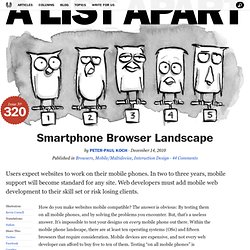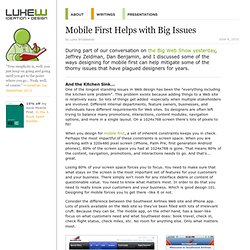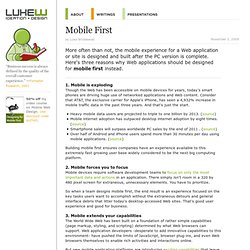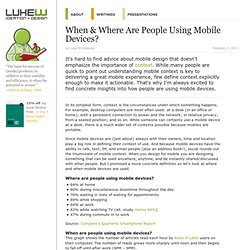

Lien 50 - A List Apart: Articles: Smartphone Browser Landscape. Users expect websites to work on their mobile phones.

In two to three years, mobile support will become standard for any site. Web developers must add mobile web development to their skill set or risk losing clients. How do you make websites mobile compatible? The answer is obvious: By testing them on all mobile phones, and by solving the problems you encounter. But, that’s a useless answer. In this article, I’ll give you an overview of the mobile web market, as well as phone platforms and their browsers, so that you can decide which mobile devices to test on. The smartphone market#section1 Web developers should concentrate their testing efforts on smartphones.
A smartphone is a phone that runs a recognizable OS on which the user can install applications. The smartphone market is divided into several submarkets, each of which has a distinct audience. Notes: In 2009, about 175 million smartphones were sold worldwide. A game of platforms#section2 Attention must be paid#section3 What about IE? Lien 49 - Web Developer. Lien 48 - Mobile First Helps with Big Issues. During part of our conversation on the Big Web Show yesterday, Jeffrey Zeldman, Dan Benjamin, and I discussed some of the ways designing for mobile first can help mitigate some of the thorny issues that have plagued designers for years.

And the Kitchen Sink... One of the longest standing issues in Web design has been the "everything including the kitchen sink problem". This problem exists because adding things to a Web site is relatively easy. So lots of things get added -especially when multiple stakeholders are involved. Different internal departments, feature owners, businesses, and individuals have different requirements for Web sites. When you design for mobile first, a set of inherent constraints keeps you in check. Losing 80% of your screen space forces you to focus. Consider the difference between the Southwest Airlines Web site and iPhone app. If you design mobile first, you create agreement on what matters most. The Same in Every Browser. Lien 47 - Mobile First. More often than not, the mobile experience for a Web application or site is designed and built after the PC version is complete.

Here's three reasons why Web applications should be designed for mobile first instead. 1. Mobile is exploding Though the Web has been accessible on mobile devices for years, today's smart phones are driving huge use of networked applications and Web content. Consider that AT&T, the exclusive carrier for Apple's iPhone, has seen a 4,932% increase in mobile traffic data in the past three years. Heavy mobile data users are projected to triple to one billion by 2013. Building mobile first ensures companies have an experience available to this extremely fast growing user base widely considered to be the next big computing platform. 2. Mobile devices require software development teams to focus on only the most important data and actions in an application. Lien 46 - Noise to Noise Ratio : un album. Lien 45 - When & Where Are People Using Mobile Devices? It's hard to find advice about mobile design that doesn't emphasize the importance of context.

While many people are quick to point out understanding mobile context is key to delivering a great mobile experience, few define context explicitly enough to make it actionable. That's why I'm always excited to find concrete insights into how people are using mobile devices. In its simplest form, context is the circumstances under which something happens. For example, desktop computers are most often used: at a desk (in an office or home); with a persistent connection to power and the network; in relative privacy; from a seated position; and so on.
While someone can certainly use a mobile device at a desk, there is a much wider set of contexts possible because mobiles are portable. Since mobile devices are (just about) always with their owners, time and location play a big role in defining their context of use. Lien 44 - News Blog - Mobile shopping is popular when watching TV, says Orange UK research.
It’s time for yet another Christmas mobile shopping report.

This one comes from Orange UK, which has been talking to customers using its Orange World mobile portal. Almost a third (31%) of mobile shoppers have been ‘multitasking’ by looking for presents whilst also watching TV – and around a fifth (18%) have been leaving their mobile shopping until bedtime. 13% shop for presents from their mobile whilst at work, while 11% shop during their commute to and from work. Overall, the top day for mobile shopping was Saturday. Orange says the top five most searched for retailers on Orange World were Amazon, Argos, eBay, Asda and Tesco.
Steve Ricketts, Head of Mobile Commerce at Orange UK, said “Mobiles are making shopping easier this Christmas, as people can buy presents in secret from their phones - without worrying about being overlooked or found out by anyone.